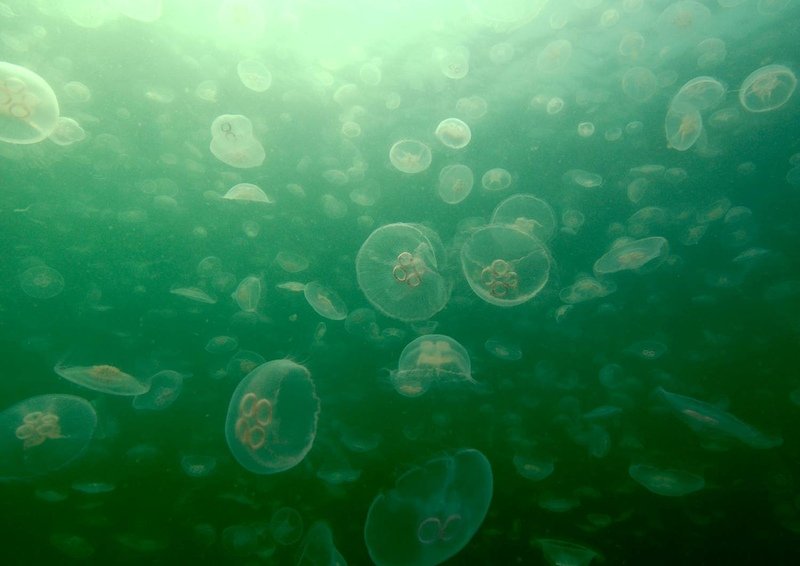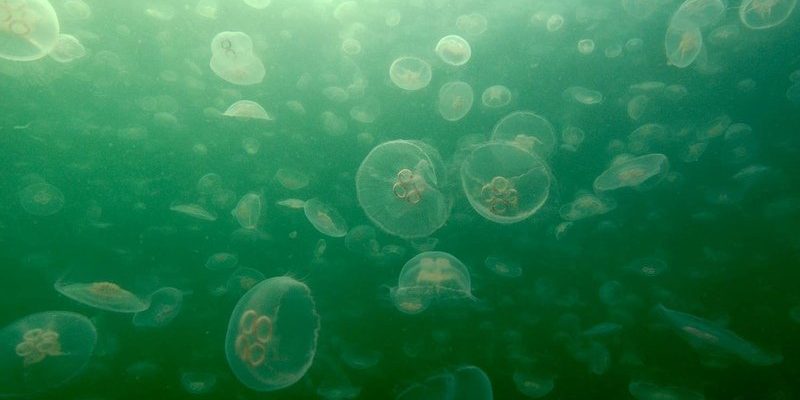
Have you ever seen a Moon Jellyfish? These mesmerizing creatures are like floating umbrellas, gracefully pulsating through the water. Their translucent bodies and gentle movements can capture anyone’s attention, making them a favorite at aquariums and in our oceans. But there’s so much more to these jellyfish than meets the eye!
Moon Jellyfish, scientifically known as Aurelia aurita, are one of the most common species found around the world. They thrive in both warm and cold waters, from coastal regions to the open sea. With their lovely, bell-shaped bodies and long, trailing tentacles, they have an almost ethereal quality. Despite their beauty, there are fascinating facts that reveal their unique biology, diet, and role in marine ecosystems.
Physical Characteristics
Moon Jellyfish are known for their distinctive appearance. Their bodies are mostly transparent, allowing you to see their internal structures. The umbrella, or bell, can reach up to 16 inches (40 cm) across, but they can grow even larger in some cases. Most Moon Jellyfish have a smooth, dome-shaped top that is usually a pale blue or pink hue. Their long, delicate tentacles trail beneath them, often giving the impression of floating ribbons in the water.
In addition to their beautiful looks, Moon Jellyfish have some fascinating features. They possess specialized cells called nematocysts, which help them capture prey. While they are not harmful to humans, their stinging cells can cause mild irritation if touched. The true beauty lies in their composition; their bodies are made up of about 95% water, leading people to describe them as ‘gelatinous.’ This gives them that squishy feel and allows them to float so effortlessly.
Interestingly, the colors of Moon Jellyfish can change with their environment. They often display bioluminescence, which is a glimmering glow that can be seen in dark waters. This phenomenon is mesmerizing and adds to their charm. Just imagine swimming in the ocean at night and coming across a glowing Moon Jellyfish; it’s like encountering a piece of magic!
Habitat and Distribution
Moon Jellyfish are quite adaptable and can be found in a range of marine environments. They typically inhabit coastal waters and estuaries but are also common in open oceans. From the Pacific to the Atlantic and even in the Mediterranean Sea, these jellyfish thrive in various temperatures and conditions. Their ability to tolerate a range of salinity levels makes them unique among jellyfish species.
They are often found in areas with abundant plankton, their primary food source. Moon Jellyfish prefer warmer waters but have been documented in regions with colder climates too. They can sometimes be seen washed up on beaches, where they can surprise beachgoers with their otherworldly beauty.
In recent years, researchers have noticed an increase in Moon Jellyfish populations in certain areas. While this might sound lovely, it can lead to ecological imbalances. When jellyfish blooms occur, they can deplete local fish populations and disrupt marine ecosystems. So, while they’re stunning to watch, they also play a role in the delicate balance of ocean life.
Diet and Feeding Habits
Moon Jellyfish are fascinating creatures when it comes to their diet. They primarily feed on tiny plankton, including small fish eggs, larvae, and other microscopic organisms. Their tentacles play a crucial role in capturing food. As they drift through the water, these jellyfish use their tentacles to sting and immobilize their prey before bringing it to their mouth located on the underside of their bell.
One interesting aspect of their feeding habits is their ability to filter feed. Moon Jellyfish can absorb small particles directly from the water. This allows them to thrive in areas where food might not always be plentiful. It’s almost like having a buffet available at all times! They can consume large quantities of water, expelling it after extracting nutrients, which promotes a healthy ecosystem by cycling nutrients.
However, their diet can change based on availability. If plankton populations decline, Moon Jellyfish will adapt by feeding on other tiny marine organisms. This adaptability helps them survive in various habitats and conditions, contributing to their resilience as a species.
Reproduction and Lifespan
Reproduction in Moon Jellyfish is a fascinating process. They reproduce both sexually and asexually, depending on environmental conditions. During the warmer months, adult Moon Jellyfish engage in sexual reproduction, releasing sperm and eggs into the water. This external fertilization results in fertilized eggs that develop into free-swimming larvae called planulae.
Once the planulae settle on a surface, they grow into polyps, which can asexually reproduce and create more jellyfish. This cycle continues, allowing for rapid population growth under favorable conditions. It’s like a jellyfish factory operating right on the ocean floor!
As for their lifespan, Moon Jellyfish typically live for about 1 to 3 years in the wild, although some can survive longer in controlled environments like aquariums. Their changing life stages, from larva to polyp to mature jellyfish, show how adaptable and resilient they are in the vast ocean.
Interactions with Humans
Interactions between humans and Moon Jellyfish can take various forms. In some coastal communities, they are seen as beautiful and fascinating creatures, often featured in aquariums and marine exhibits. Their appearance in these settings allows people to appreciate their unique beauty up close. They can captivate both young and old alike, educating us about marine life and ecosystems.
However, there are also some downsides to these interactions. Though Moon Jellyfish are generally harmless, their presence in large numbers can lead to beach closures and disrupt fishing activities. Fishermen may face challenges when their nets become clogged with jellyfish, affecting their catch. It’s essential to balance appreciation for these creatures with the ecological impacts they may have.
Some cultures even celebrate Moon Jellyfish in art and folklore, illustrating their impact beyond the ocean. This appreciation shows the interconnectedness of marine life and human experience. So, while you might admire them for their beauty, understanding their role in the ecosystem can deepen that admiration.
| Characteristic | Details |
| Size | Up to 16 inches (40 cm) across |
| Habitat | Coastal and open waters worldwide |
| Diet | Plankton, small fish eggs, and larvae |
| Lifespan | 1 to 3 years in the wild |
| Predators | Sea turtles, some fish species |
| Reproductive method | Sexually and asexually |
Conservation Status
Interestingly, the conservation status of Moon Jellyfish is not as precarious as some other marine species. They are abundant in many parts of the world, and their populations are not currently threatened. However, their presence can indicate the health of marine ecosystems. A significant increase in jellyfish populations can sometimes signal overfishing or changes in marine environments.
Despite their current status, monitoring Moon Jellyfish populations is important for understanding broader ocean health. They serve as indicators of ecological changes. As climate change continues to affect our oceans, observing how jellyfish populations shift can provide valuable insight into marine ecosystems.
Furthermore, increasing pollution levels and habitat destruction threaten many marine species. While Moon Jellyfish are adaptable, their reliance on healthy ecosystems for food and breeding means they can be affected indirectly by environmental changes. It’s crucial to advocate for better ocean conservation efforts to sustain their populations as well as the entire marine environment.
FAQ
What do Moon Jellyfish look like?
Moon Jellyfish have a distinctive appearance characterized by their umbrella-like, translucent bodies. They often display a dome-shaped top that can be pale blue or pink, with long, trailing tentacles that dangle below. Their bodies are about 95% water, giving them a gelatinous feel and allowing them to float gracefully in the ocean.
Are Moon Jellyfish dangerous to humans?
Generally, Moon Jellyfish are not dangerous to humans. While they do possess stinging cells called nematocysts, their sting is mild and usually causes only slight irritation. Most people feel a tingling sensation, similar to a light burn, if they come into contact with one. However, it’s always best to admire them from a distance.
Where can you find Moon Jellyfish?
Moon Jellyfish are found in various marine environments, including coastal waters, estuaries, and the open ocean. They thrive in different temperature ranges, from warm tropical waters to cooler regions. These jellyfish are often spotted in places with abundant plankton, which they rely on for food.
How do Moon Jellyfish reproduce?
Moon Jellyfish reproduce both sexually and asexually. During warmer months, they release sperm and eggs into the water for external fertilization. The fertilized eggs develop into larvae called planulae, which settle on surfaces and grow into polyps. From polyps, more jellyfish are produced, continuing the cycle of life.
What is the lifespan of a Moon Jellyfish?
Moon Jellyfish typically live for about 1 to 3 years in the wild. Their lifespan can be influenced by environmental conditions, availability of food, and predation. In controlled environments like aquariums, they may live longer due to better diet and protection.
Can Moon Jellyfish be found in aquariums?
Yes, many aquariums feature Moon Jellyfish due to their stunning appearance and fascinating behavior. They are relatively easy to care for in captivity, making them popular among aquarium enthusiasts. Observing them up close can provide valuable insights into their biology and behavior.
What role do Moon Jellyfish play in the ecosystem?
Moon Jellyfish play a crucial role in marine ecosystems. They primarily feed on plankton, helping to regulate these populations and maintain balance in their environments. Additionally, they serve as a food source for various predators, including sea turtles and some fish, contributing to the marine food web.
Are there any threats to Moon Jellyfish populations?
While Moon Jellyfish are currently abundant, they can be affected by changes in marine environments caused by pollution, climate change, and overfishing. An increase in jellyfish populations can indicate ecological imbalances, so monitoring these populations is essential for understanding ocean health.
How do Moon Jellyfish move through the water?
Moon Jellyfish move by contracting and relaxing their bell-shaped bodies, creating a rhythmic pulsation that propels them through the water. This movement is energy-efficient, allowing them to drift along with ocean currents while also providing a means of finding food.
What is the scientific name of Moon Jellyfish?
The scientific name for Moon Jellyfish is Aurelia aurita. This name is derived from its resemblance to a round umbrella and its moon-like appearance. Understanding its scientific classification helps in studying its biology and ecology more effectively.
What is bioluminescence in Moon Jellyfish?
Bioluminescence refers to the ability of certain organisms to produce light. Moon Jellyfish can display bioluminescence, creating a mesmerizing glow in dark waters. This phenomenon may help them scare predators or attract prey, adding to their ethereal beauty.
How do Moon Jellyfish contribute to marine research?
Moon Jellyfish are valuable for marine research as they provide insights into ecosystem health. Their populations can signal environmental changes, such as water quality and temperature shifts. Studying their behavior and life cycle can also help scientists understand broader marine biology concepts.
Is it safe to touch Moon Jellyfish if they wash up on the beach?
While Moon Jellyfish have mild stings, it’s still wise to be cautious. If you encounter one washed up on the beach, avoid touching its tentacles, as some people may still experience irritation. Observing them from a distance is the best way to appreciate their beauty while staying safe!

